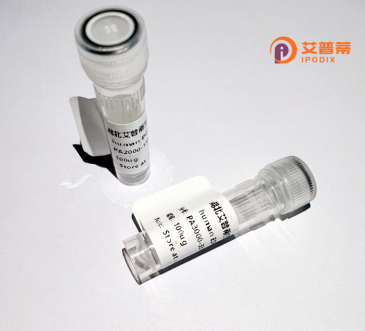
| 纯度 | >90%SDS-PAGE. |
| 种属 | Human |
| 靶点 | CEECAM1 |
| Uniprot No | Q5T4B2 |
| 内毒素 | < 0.01EU/μg |
| 表达宿主 | E.coli |
| 表达区间 | 1-517aa |
| 氨基酸序列 | MLQEWLAAVGDDYAAVVWRPEGEPRFYPDEEGPKHWTKERHQFLMELKQEALTFARNWGADYILFADTDNILTNNQTLRLLMGQGLPVVAPMLDSQTYYSNFWCGITPQGYYRRTAEYFPTKNRQRRGCFRVPMVHSTFLASLRAEGADQLAFYPPHPNYTWPFDDIIVFAYACQAAGVSVHVCNEHRYGYMNVPVKSHQGLEDERVNFIHLILEALVDGPRMQASAHVTRPSKRPSKIGFDEVFVISLARRPDRRERMLASLWEMEISGRVVDAVDGWMLNSSAIRNLGVDLLPGYQDPYSGRTLTKGEVGCFLSHYSIWEEVVARGLARVLVFEDDVRFESNFRGRLERLMEDVEAEKLSWDLIYLGRKQVNPEKETAVEGLPGLVVAGYSYWTLAYALRLAGARKLLASQPLRRMLPVDEFLPIMFDQHPNEQYKAHFWPRDLVAFSAQPLLAAPTHYAGDAEWLSDTETSSPWDDDSGRLISWSGSQKTLRSPRLDLTGSSGHSLQPQPRDEL |
| 分子量 | 85.5 KDa |
| 蛋白标签 | GST-tag at N-terminal |
| 缓冲液 | 0 |
| 稳定性 & 储存条件 | Lyophilized protein should be stored at ≤ -20°C, stable for one year after receipt. Reconstituted protein solution can be stored at 2-8°C for 2-7 days. Aliquots of reconstituted samples are stable at ≤ -20°C for 3 months. |
| 复溶 | Always centrifuge tubes before opening.Do not mix by vortex or pipetting. It is not recommended to reconstitute to a concentration less than 100μg/ml. Dissolve the lyophilized protein in distilled water. Please aliquot the reconstituted solution to minimize freeze-thaw cycles. |
以下是关于重组人CEACAM1蛋白的3篇参考文献(名称、作者及摘要概括),经确认可能存在拼写修正(CEECAM1应为CEACAM1):
1. **文献名称**:*"Recombinant soluble CEACAM1 inhibits tumor growth and enhances the antitumor immunity in mice"*
**作者**:Chen Z, et al.
**摘要**:研究报道了重组可溶性人CEACAM1蛋白通过抑制肿瘤血管生成和调节T细胞活性,在荷瘤小鼠模型中表现出显著的抗肿瘤效果。
2. **文献名称**:*"Structural basis of CEACAM1 homodimerization using recombinant protein analysis"*
**作者**:Muenzner P, et al.
**摘要**:通过重组表达和晶体学分析,揭示CEACAM1蛋白的同源二聚化结构机制,为理解其在细胞间黏附和信号传递中的功能提供依据。
3. **文献名称**:*"Expression and purification of functional recombinant human CEACAM1 in E. coli"*
**作者**:Gray-Owen SD, et al.
**摘要**:描述了一种在大肠杆菌中高效表达并纯化功能性重组人CEACAM1蛋白的方法,验证其与病原体表面配体的特异性结合能力。
---
**注**:如需要具体文献来源(期刊、年份等)或扩展内容,可进一步补充说明。建议通过PubMed或Google Scholar输入标题进行原文检索。
**Background of Recombinant Human CEACAM1 Protein**
CEACAM1 (Carcinoembryonic Antigen-Related Cell Adhesion Molecule 1) is a transmembrane glycoprotein belonging to the immunoglobulin superfamily. It plays critical roles in cell-cell adhesion, intracellular signaling, and immune regulation. Structurally, CEACAM1 contains an extracellular domain with immunoglobulin-like folds, a transmembrane region, and a cytoplasmic tail with tyrosine phosphorylation sites that mediate signaling. Alternative splicing generates multiple isoforms, including long (inhibitory) and short (activating) cytoplasmic domains, which fine-tune its functions in diverse tissues.
CEACAM1 is expressed on epithelial, endothelial, and immune cells, where it modulates processes such as angiogenesis, insulin metabolism, tumor suppression, and immune responses. In immunity, it regulates T-cell activation, neutrophil recruitment, and pathogen recognition. Dysregulation of CEACAM1 is linked to cancer progression, autoimmune diseases, and metabolic disorders, highlighting its dual role as both a tumor suppressor and promoter depending on context.
Recombinant CEACAM1 is produced using expression systems (e.g., mammalian cells, *E. coli*) to retain functional domains. Purified forms, often fused with tags (e.g., Fc, His-tag), are used to study ligand-receptor interactions, signaling mechanisms, and therapeutic targeting. Its applications span structural biology, drug discovery (e.g., immune checkpoint inhibitors), and biomarker research, underscoring its biomedical significance.
×